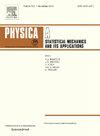Modeling structural power in hypergraphs: An application to the interstate alliances network
IF 3.1
3区 物理与天体物理
Q2 PHYSICS, MULTIDISCIPLINARY
Physica A: Statistical Mechanics and its Applications
Pub Date : 2025-06-20
DOI:10.1016/j.physa.2025.130776
引用次数: 0
Abstract
In this article, we develop a novel approach for modeling structural power in social networks, arguing that social agents also derive power from the direct or indirect social support they receive from other agents. We conceptualize structural power as a complex outcome of interconnection between agents at different scales of network structure, micro, meso, and macro. Structural power enhances the capabilities of a social agent through interdependence and emergence. Each agent benefits from the capabilities of others, so that they collectively become capable of accomplishing more than each could accomplish on its own. We model structural power using hypergraphs and Spectral Graph Theory. In this way, hyperdyadic associations and structural affinities are effectively captured. Our modeling approach is applied on the interstate alliances hypergraph. We find that taking into account structural power is crucial for detecting latent power interdependencies, for revealing the full extent of the capabilities of prominent states, and for enhancing power comparisons. The contemporary relevance of our findings is highlighted by the Russo-Ukrainian war as well as the Iran-Israel war.
超图中的结构权力建模:在州际联盟网络中的应用
在本文中,我们开发了一种新的方法来建模社会网络中的结构性权力,认为社会代理人也从他们从其他代理人那里获得的直接或间接的社会支持中获得权力。我们将结构性权力概念化为不同尺度的网络结构(微观、中观和宏观)上的主体之间相互联系的复杂结果。结构性权力通过相互依赖和涌现增强了社会主体的能力。每个主体都能从其他主体的能力中获益,因此,它们共同具备了比单独完成更多任务的能力。我们利用超图和谱图理论对结构功率进行建模。通过这种方式,超二元关联和结构亲和性被有效地捕获。我们的建模方法应用于州际联盟超图。我们发现,考虑结构性权力对于发现潜在的权力相互依赖性、揭示主要国家能力的全部程度以及加强权力比较至关重要。我们的研究结果的当代相关性被俄罗斯-乌克兰战争以及伊朗-以色列战争所突出。
本文章由计算机程序翻译,如有差异,请以英文原文为准。
求助全文
约1分钟内获得全文
求助全文
来源期刊
CiteScore
7.20
自引率
9.10%
发文量
852
审稿时长
6.6 months
期刊介绍:
Physica A: Statistical Mechanics and its Applications
Recognized by the European Physical Society
Physica A publishes research in the field of statistical mechanics and its applications.
Statistical mechanics sets out to explain the behaviour of macroscopic systems by studying the statistical properties of their microscopic constituents.
Applications of the techniques of statistical mechanics are widespread, and include: applications to physical systems such as solids, liquids and gases; applications to chemical and biological systems (colloids, interfaces, complex fluids, polymers and biopolymers, cell physics); and other interdisciplinary applications to for instance biological, economical and sociological systems.

 求助内容:
求助内容: 应助结果提醒方式:
应助结果提醒方式:


